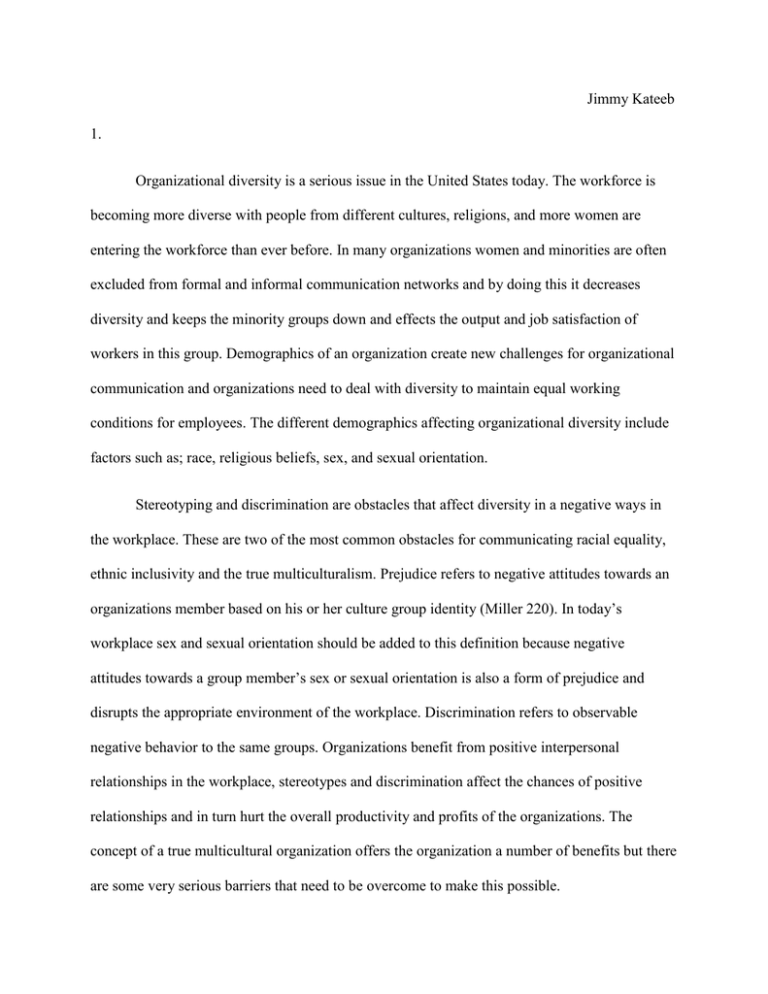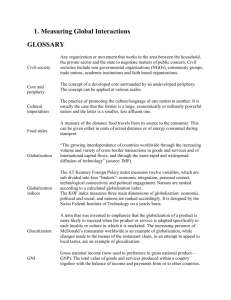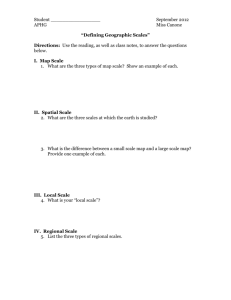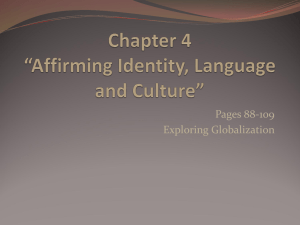Human Resource Development
advertisement

Jimmy Kateeb 1. Organizational diversity is a serious issue in the United States today. The workforce is becoming more diverse with people from different cultures, religions, and more women are entering the workforce than ever before. In many organizations women and minorities are often excluded from formal and informal communication networks and by doing this it decreases diversity and keeps the minority groups down and effects the output and job satisfaction of workers in this group. Demographics of an organization create new challenges for organizational communication and organizations need to deal with diversity to maintain equal working conditions for employees. The different demographics affecting organizational diversity include factors such as; race, religious beliefs, sex, and sexual orientation. Stereotyping and discrimination are obstacles that affect diversity in a negative ways in the workplace. These are two of the most common obstacles for communicating racial equality, ethnic inclusivity and the true multiculturalism. Prejudice refers to negative attitudes towards an organizations member based on his or her culture group identity (Miller 220). In today’s workplace sex and sexual orientation should be added to this definition because negative attitudes towards a group member’s sex or sexual orientation is also a form of prejudice and disrupts the appropriate environment of the workplace. Discrimination refers to observable negative behavior to the same groups. Organizations benefit from positive interpersonal relationships in the workplace, stereotypes and discrimination affect the chances of positive relationships and in turn hurt the overall productivity and profits of the organizations. The concept of a true multicultural organization offers the organization a number of benefits but there are some very serious barriers that need to be overcome to make this possible. There are a number of different programs an organization can utilize to maintain or help the transformation of communicating racial equality, ethnic inclusivity, or true multiculturalism to their organization. The first thing an organization should do to promote diversity is have the understanding that diversity is challenge and an opportunity rather than a nuisance that the organization has to do to comply with laws. If the organization feels that diversity is a nuisance there is little chance to sustain diversity over time. The workforce also needs to be educated about diversity through diversity training. Next the organization needs to establish the culture as a culture that promotes and appreciates diversity. There are five steps that are used to transform an organization to organization that plans to achieve multiculturalism. They are leadership, training, research, analysis and change of culture and human resource management systems, and follow-up. In the first step leadership, this shows that top management must be truly committed to diversity. Top management must understand and expect diversity from employees and management needs to lead by example. Second, employees must receive diversity awareness training and skill building training. By doing this employee’s will receive the proper knowledge, attitudes, skills and habits that are involved within diversity. In this step it involves changing mind sets or stereotypes by promoting knowledge and acceptance. Third, the organization should do their research about the organizations culture to identify if there any problems that need to be fixed and if there are, what educational programs would be needed to fix these problems. The next stage is change of culture and human resource management systems. This stage involves and identifies ways that certain minority groups within the organization could be hampered by the organizations current values. This stage is the most difficult stage for organizations to accomplish. The organization needs to understand what different values each group within the organization has and incorporate these values into ways in which the members can accomplish work without disadvantage to the group doing the task. The last stage is follow-up; in this stage it is important that the organization constantly checks on education, training, and the organizational culture to make sure all programs are working and applicable to the groups that are employed. When organization leaders are concerned with promoting diversity in the workplace they should consider using the systems approach. This approach set examples that women and minority groups are essential members of the organization. In the systems approach “Diversity would be seen as an important avenue for the organization to adapt effectively to a turbulent global environment. Systems scholars might address the integration of women and minorities into formal and informal communication networks (Miller 234). The systems approach would help the organization understand the values and needs of the groups they included in the organizations communication. When this happens it would also give the chance for women and minority group members to have a chance to move up in the organization removing the glass ceiling and then this would show all other minority group members that the company is serious about diversity and anyone can make it in the organization regardless of sex or race. The government has set up policies to help ensure that the rights of minorities and women are watched over because these groups have been discriminated against so often throughout the history of the United States. The Civil Rights Act of 1964 marked the beginning of programs set up to ensure equal opportunity in the workplace. Affirmative action programs were designed from the civil rights act “to remedy discrimination and increase the representation of designated disadvantaged groups, namely, women and ethnic minorities” (Miller 228). Organizations wanting to reach true multiculturalism can set up a variety of programs to accomplish their goals and with hard work they can reach their goals, but the problem is not all organizations want to, and these organizations will discriminate against minorities keeping them as second class citizens and this is why affirmative action is needed. Affirmative action has plenty of critics saying it stigmatizes workers or it emphasizes preferential treatment. But the success of affirmative action is representing the rights of group members that are discriminated against and giving them a fair chance to compete in the job market and in their organizations. In 1980 the Equal Employment Opportunity Commission (EEOC) stated that any sexual harassment is a kind of discrimination under Title VII of the Civil Rights Act of 1964. There are a number of different communication behaviors that can be considered sexual harassment. This law was set up to protect the rights of any employee that feels their working environment is being threatened by sexual advances from fellow employees. Organizations must communicate to employees that sexual harassment will not be tolerated at any level. Sexual harassment leads to many communication problems in the workplace and could in some cases lead to the firing of the offender. Women face more barriers than men do in the workplace for the fact in our society women are expected to take care of their children while their husbands work. In 1993 the Family and Medical Leave Act (FMLA) was passed, most federal employees are entitled to a total of up to 12 work weeks of unpaid leave during any 12-month period for the following purposes: the birth of a son or daughter of the employee and the care of such son or daughter; the placement of a son or daughter with the employee for adoption or foster care; the care of spouse, son, daughter, or parent of the employee who has a serious health condition; or a serious health condition of the employee that makes the employee unable to perform the essential functions of his or her positions. This act allows women to return to their same or equivalent position and they will receive the same benefits they had before leaving. These programs and policies have offered plenty of cases of success to the rights of women and minority workers. If an employee is being discriminated against this will affect the employee’s job satisfaction and a low level of job satisfaction decreases an employee’s productivity thus decreasing the profits of the organization. Discrimination in the workplace clearly violates the Civil Rights Act of 1964 so to discriminate against an employee breaks the law and could lead to law suits. The government has set up policies to deter discrimination and employers have set up a number of approaches and programs to help educate people about diversity and help organization reach their goals as a multicultural organization. People need to understand the different cultures and how people from different cultures use language to express their selves and implement these practices in their diversity training programs. 2. Today we live in a global economy and organizations need to be able to adapt to this to truly benefit their selves. With the innovations in technology our world is becoming smaller and smaller and organizations are able to communicate with a branch or a supplier on the other side of the world in just seconds. With the use of communication technology organizations are able to market their business to any place in the world. There are both pros and cons to globalization, globalization affects many people differently, some people get filthy rich because of it and some people lose their jobs because of it. Without the innovations in technology it would not be possible for globalization to exist. Globalization allows for “rapidly developing processes of complex interconnections between societies, cultures, institutions, and individuals worldwide” (Miller 259). An example of this would be Microsoft’s tech assistants working and living in India. Communication technologies and the ease of air travel have made it customary for the ease of globalization. American companies like McDonalds and Wal-Mart can have their central offices in the United States but they can still have stores all over the world. Wal-Mart runs their central office out of Arkansas and from Arkansas they can communicate with every other branch shipping orders all over the world using communication technology. In most cases communication technology is a great thing that makes our lives easier and more efficient but in terms of globalization, the advances in communication technology have made globalization a reality and in turn has cost Americans a large number of jobs. The capitalist society we live in is set up to for companies to compete with each other creating lower prices for consumers. The way big organization are able to get prices so low is by outsourcing jobs to developing countries and these organizations get the same work done at a fraction of the price. Corporations in developed countries like the United States have moved their manufacturing plants to Third World countries like China, Vietnam, and Bangladesh. Even if a company wanted stay in the United States and not outsource jobs to other developing countries the company would have a hard time staying in business because most competitors would be making an equal product much cheaper and selling that product cheaper. The products we buy that are made in other countries do not have to follow the same laws that we do here in America, like child labor laws and health standards that we follow in this country saving organizations millions of dollars more. Globalization affects many different groups differently. I believe that globalization has actually hurt the American economy for the fact that we do not manufacture goods like we use to and with all the debate about the creation of jobs in the country today it is pretty safe to say outsourcing is what happened to these jobs. Americans need to look elsewhere than the manufacturing of good to create jobs because of globalization. For business owners of organizations, globalization has been great they get labor much cheaper, they don’t have to worry about strict American laws, and they are always open somewhere in the world. “Globalization results in time and space compression, changing communication patterns and perceptions. In the global workplace everything moves quickly – you can be in Tokyo one day and in Cleveland the next, and it’s always the beginning of the workday somewhere on the globe. Space and time are no longer directly connected” (Miller 261). In the process of the rich getting richer it hurts the majority of Americans from the loss of work. I would determine that there is a direct correlation between the advances in communications technologies to the loss of American jobs. A combination of the words "globalization" and "localization" used to describe a product or service that is developed and distributed globally, but is also used to accommodate the user or consumer in a local market. This means that when organizations are using glocalization they are going to tailor their products to meet the needs and customs of the population they are serving. One example of glocalization would be McDonalds in India, diets in India are often impacted by the many different religions in India. Hindus don't eat beef, so there is no beef on the McDonalds' menu in India. Muslims don't eat pork, so for the McDonalds Corporation in India not only is there no beef, there is no pork or pork byproducts in any McDonald’s restaurant in India. India has a high population of vegetarians so about half of the menu at McDonalds in India is vegetarian, which makes it a good choice for customers who want some healthy options whether or not they are vegetarian. When organizations want to use glocalization it is important that the organization communicates with the area they want to glocalize in. Organization must be able to prove to their external stakeholders (customers) that they will be able to provide them with products that meet their needs. Before glocalization can be accomplished the organization must be able to communicate to the area that they can meet these needs if they cannot do this there is little chance for success. This involves studying the customs of the area they want to expand in to and see if they will be accepted. For the McDonalds in India, the McDonalds Corporation would have to test the products to make sure they could offer these products in a way that meets the McDonalds standards; which is fast, tasty food at inexpensive prices. To meet the needs of the internal stakeholders the McDonalds Corporation would have to train their American upper executive management in the cultures of the people from India because these would be the employees that would be going over there and opening the restaurants. These employees would have to understand how to communicate appropriately with the people from India that will be working at the restaurants. 3. Communication technology is a constantly changing phenomenon that members of an organization will have to change with to keep up with the workplace that is becoming more innovative and efficient. Communication technology makes the world a smaller place where one organization can be centrally located at an office and communicate to all other locations from their main location. In the past decade communication technology has made great leaps. Communication technology has become much faster, the dial up days of internet are now over. With everyone having high speed internet we can send a message to anyone in the world in a matter of seconds. Today most people walk around with computers on them, most phones have the ability to check email and send and open files. So to send and receive email is a simple as hitting a few buttons on your phone rather than having to be at your desk in your office. These wireless networks are in my opinion the greatest advance in communication technology in the past ten years. Communicating with the organizations stakeholders has become much easier for organizations to accomplish with the common use of the internet. Organizations are able to sell and market products to anywhere in the world with use of the internet any major organization today has sophisticated ways of promoting, advertising and explaining the purpose of the organization to the world, a decade ago this was not as common. If an organization is not on the World Wide Web they probably do not have much of a chance of succeeding. Computer conferencing is another example of how communication technology has come so far in the past decade. It has allowed organizations to conduct business meetings in a conference room with people from all over the world with video feeds. Communication technology greatly enables social dimensions of the workplace by allowing fast efficient communication by email, video conference or a variety of other technological ways. The employee becomes more efficient when using communication technology, but there can be occasions when communication technology constrains the social dimensions of the workplace. When people communicate via email, conference call, or another method of communication technology, they are not able to pick up on nonverbal cues that coworkers would observe in face to face meetings and this “filters out” (Miller 241) communication cues. What communication technology makes up for with efficiency it can in some cases constrain the communication of nonverbal clues that a worker would receive in a face to face meeting. There are three theories of organizational technology that we discussed in class. The first model was the media richness model; this model was the first model to be used by organizations. The next two models dual-capacity model and social information processing model came onto the scene later. The following two models were implemented to address perceived weaknesses with the media richness model. “The media richness model was proposed by Daft and Lengel (1984, 1986) as a framework for understanding the choices organizational members make about communication media use” (Miller 242). The media richness model says that employers should use the appropriate media for the appropriate message. Different organizational task vary in their level of ambiguity. “Ambiguity refers to the existence of conflicting and multiple interpretations of an issue” (Miller 242). For instance, if management wanted to inform employees about a meeting it would be appropriate to send a proper email with something in the subject line stating there was a meeting coming up. This would be considered lean media and as simple communication. On the other end of the spectrum, if executives wanted to communicate a problem to all store managers in a region and wanted to receive feedback, it would be appropriate to have a video conference call to express all problems and open lines of communication to resolve the problem. This would be considered rich media because the executives would want instant feedback, the use of multiple cues, and the use of natural language. The social information processing model is the next model. “In adopting a social information processing model, these theorists argue that communication between coworkers, supervisors, customers, and others affects media usage” (Miller 244). This theory states that workers will base their levels of communication technology on social information they have heard from people within their organization. People from the social information processing model approach the use of communication technology as a complex function of the objective characteristics of the task and media, past experience and knowledge, individual differences, and social information. An example of this would be a Human Resource department that just received new Human Resource Information Systems (HRIS) software and this software was to keep track of all employee files and records. One of the workers has a friend in a different HR department that was given the same HRIS software to use and she told her friend that she had a terrible time using this software and it made her job more difficult. Even though the software is made to make the HR workers job easier and all it took was some simple training to master the software but the workers friend did not receive the training. This is a social influence that affected the way technology was used in an organization. The second alternative to the media richness theory is the dual-capacity model. This theory suggests that every organizational message has the ability to carry two kinds of messages. “The first of these mediums is data-carrying capacity, defined as the degree to which a medium is able to effectively convey task–relevant data” (Miller 246). This means that some media will have the same data carrying capacity in all organizational settings. The second is symbol- carrying capacity. “The symbol-carrying capacity of a medium can be manifest in several ways. First, media can be more or less able to convey the core values and assumptions that constitute the organizations culture. Second, a communication medium can attain the status of symbol apart from the actual message being transmitted.”(Miller 246) “For example, a meeting conducted via video conferencing can carry symbolic messages about the importance of and technological sophistication of the meeting participants.”(Miller 246) Technology is becoming more and more present in organizational life and when studying technology in the workplace there are many factors involved. Technology offers employees the opportunity to avoid work, whether it is an employee chatting with friends or paying his bills online, this is time the employee should be working and this cut’s into productivity. Many companies have policies where the monitor employees computers to see if this is a problem. “Almost 80% of U.S. firms conduct surveillance on their employees. Half monitor phone call by listening or recording” (Miller 27). Organizations need to state in employee handbooks that this is not appropriate behavior. To avoid possible problems with communicating technology, organization should offer training to employees with new technology the company receives. Communication technology can be very expensive for organizations so it is important for organizations to budget money for new technologies and hire employees with technological backgrounds to help the company move forward. Finally some people can feel overburden from an overload of information such as emails, pagers, faxes, cell phones, and so on. This can result in too much information and actually hurt productivity. Ways of dealing with these problems could be to increase the flexibility of employees and more teamwork.





